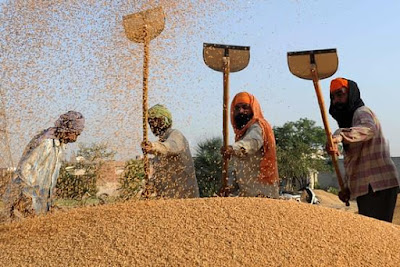6FTF Large Scale Wheat Flour Mill Plant
http://www.wheatmillmachinery.com/project/large-scale-flour-mill-plant.htmlAvailable Capacity:60T per 24 hours
80T per 24 hours
100T per 24 hours
150T per 24 hours
300T per 24 hours
500T per 24 hours
Features
2.Cleaning: The removal of impurities like stones, dirt, metals and other seeds.
80T per 24 hours
100T per 24 hours
150T per 24 hours
300T per 24 hours
500T per 24 hours
Introduction
6FTF series large wheat processing equipment, its product models are 60,80,100,120,150 and 200,500tons of equipment. It uses 25 series of compound milling machine or automatic pneumatic grinding mill, square plansifter to sieve powder, clean powder and impact loose powder combination, and greatly improve the purity of flour, so it can produce grade flour and special flour. The device can use a three-story layout, you can also use slightly higher house installation.
6FTF series large wheat processing equipment, its product models are 60,80,100,120,150 and 200,500tons of equipment. It uses 25 series of compound milling machine or automatic pneumatic grinding mill, square plansifter to sieve powder, clean powder and impact loose powder combination, and greatly improve the purity of flour, so it can produce grade flour and special flour. The device can use a three-story layout, you can also use slightly higher house installation.
Features
1.High degree of automation equipment
2.Beautiful and atmosphere
3.Stable and reliable performance
4.It is the ideal equipment for the upgrading medium sized flour mills
5.The factory provides one-stop service, turnkey project implementation, so that customers no worries.
Milling Process
Wheat flour milling contains the following five basic steps: preparing the wheat, cleaning, tempering, gristing, milling.
1.Preparing the wheat: Where the wheat is weighed, inspected and graded;
2.Beautiful and atmosphere
3.Stable and reliable performance
4.It is the ideal equipment for the upgrading medium sized flour mills
5.The factory provides one-stop service, turnkey project implementation, so that customers no worries.
Milling Process
Wheat flour milling contains the following five basic steps: preparing the wheat, cleaning, tempering, gristing, milling.
1.Preparing the wheat: Where the wheat is weighed, inspected and graded;
2.Cleaning: The removal of impurities like stones, dirt, metals and other seeds.
3.Tempering: During this stage the wheat is soaked in water to make it easier to remove the outer bran layer.
4.Gristing: This involves mixing different wheat to create a specific kind of flour.
5.Milling: Involves a number of repeated steps: The wheat is ground by a machine equipped with rollers that break it into pieces. Then it is put through sifters. The resulting meal starts out coarse and with repeated grinding and sifting becomes fine white flour, wheat bran and wheat germ. The milling process can either produce distinct products—wheat bran, refined white flour, wheat germ-that can be packaged and sold separately, milled together to produce a whole grain flour, or blended to form different flours.
4.Gristing: This involves mixing different wheat to create a specific kind of flour.
5.Milling: Involves a number of repeated steps: The wheat is ground by a machine equipped with rollers that break it into pieces. Then it is put through sifters. The resulting meal starts out coarse and with repeated grinding and sifting becomes fine white flour, wheat bran and wheat germ. The milling process can either produce distinct products—wheat bran, refined white flour, wheat germ-that can be packaged and sold separately, milled together to produce a whole grain flour, or blended to form different flours.
6.Blending: different components are blended back together to form different flours. For example, whole wheat flour is a blend of white flour and wheat bran.
7.Enriching & Fortifying: The addition of vitamins and minerals identified in government regulations.
7.Enriching & Fortifying: The addition of vitamins and minerals identified in government regulations.








评论
发表评论